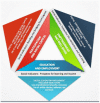Exploring the Connection of Brain Computer Interfaces and Multimedia Use With the Social Integration of People With Various Motor Disabilities: A Questionnaire-Based Usability Study
- PMID: 35990018
- PMCID: PMC9385967
- DOI: 10.3389/fdgth.2022.846963
Exploring the Connection of Brain Computer Interfaces and Multimedia Use With the Social Integration of People With Various Motor Disabilities: A Questionnaire-Based Usability Study
Abstract
We have designed a platform to aid people with motor disabilities to be part of digital environments, in order to create digitally and socially inclusive activities that promote their quality of life. To evaluate in depth the impact of the platform on social inclusion indicators across patients with various motor disabilities, we constructed a questionnaire in which the following indicators were assessed: (i) Well Being, (ii) Empowerment, (iii) Participation, (iv) Social Capital, (v) Education, and (vi) Employment. In total 30 participants (10 with Neuromuscular Disorders-NMD, 10 with Spinal Cord Injury-SCI, and 10 with Parkinson's Disease-PD) used the platform for ~1 month, and its impact on social inclusion indicators was measured before and after the usage. Moreover, monitoring mechanisms were used to track computer usage as well as an online social activity. Finally, testimonials and experimenter input were collected to enrich the study with qualitative understanding. All participants were favorable to use the suggested platform, while they would prefer it for longer periods of time in order to become "re-awakened" to possibilities of expanded connection and inclusion, while it became clear that the platform has to offer them further the option to use it in a reclining position. The present study has clearly shown that the challenge of social inclusion cannot be tackled solely with technology and it needs to integrate persuasive design elements that foster experimentation and discovery.
Keywords: Brain Computer Interfaces; Parkinson's disease; motor disabilities; neuromuscular disorders; social inclusion; spinal cord injury.
Copyright © 2022 Lazarou, Nikolopoulos, Georgiadis, Oikonomou, Mariakaki and Kompatsiaris.
Conflict of interest statement
AM was employed by Muscular Dystrophy Association, Hellas. The remaining authors declare that the research was conducted in the absence of any commercial or financial relationships that could be construed as a potential conflict of interest.
Figures





Similar articles
-
What predictors are associated with the social inclusion of people with disabilities? A comparison of community-based rehabilitation participants to the general population in Vietnam.Disabil Rehabil. 2021 Mar;43(6):815-822. doi: 10.1080/09638288.2019.1643413. Epub 2019 Jul 23. Disabil Rehabil. 2021. PMID: 31335213
-
Adaptive Esports for People With Spinal Cord Injury: New Frontiers for Inclusion in Mainstream Sports Performance.Front Psychol. 2021 Apr 15;12:612350. doi: 10.3389/fpsyg.2021.612350. eCollection 2021. Front Psychol. 2021. PMID: 33935866 Free PMC article.
-
Employment, social capital, and community participation among Israelis with disabilities.Work. 2014;48(3):381-90. doi: 10.3233/WOR-131779. Work. 2014. PMID: 24284676
-
Spinal cord injury medicine. 6. Economic and societal issues in spinal cord injury.Arch Phys Med Rehabil. 2007 Mar;88(3 Suppl 1):S84-8. doi: 10.1016/j.apmr.2006.12.005. Arch Phys Med Rehabil. 2007. PMID: 17321854 Review.
-
Brain-computer interfaces for communication and control.Clin Neurophysiol. 2002 Jun;113(6):767-91. doi: 10.1016/s1388-2457(02)00057-3. Clin Neurophysiol. 2002. PMID: 12048038 Review.
Cited by
-
Investigating the interplay of loneliness, computer-mediated communication, online social capital, and well-being: insights from a COVID-19 lockdown study.Front Digit Health. 2024 Jun 14;6:1289451. doi: 10.3389/fdgth.2024.1289451. eCollection 2024. Front Digit Health. 2024. PMID: 38946729 Free PMC article.
-
Eliciting brain waves of people with cognitive impairment during meditation exercises using portable electroencephalography in a smart-home environment: a pilot study.Front Aging Neurosci. 2023 May 30;15:1167410. doi: 10.3389/fnagi.2023.1167410. eCollection 2023. Front Aging Neurosci. 2023. PMID: 37388185 Free PMC article.
References
-
- Chen SY, Tsai ST. The epidemiology of Parkinson's disease. Tzu Chi Med J. (2010) 22:73–81. 10.1016/S1016-3190(10)60044-4 - DOI
LinkOut - more resources
Full Text Sources

